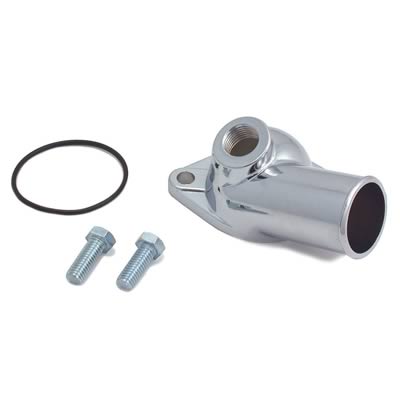it basicly uses the original two outlets and makes them both face one way.There might be a thermostat hiding in that top outlet.
So do you want to keep it "as stock as possible"??

Hi, I emailed intecracing.com for information on how the Garage Annex water block works but no answer yet. I don't know if anybody can help figure out how this water block work. I don't know if I can use a thermostat with this setup, and if it can be used how does this work. Will it work just like the stock system? Does this water block have a bypass system or do I really need one?
I was planning to replicate this water block system since its way over my budget. I've considered other setups like using the 4AGE 16v water pump and others but I want to leave the system as stock as possible. I'm not using heaters btw. Any help would be appreciated. Below you can see images of the Garage Annex water block and water necks that I'm planning of using.

it basicly uses the original two outlets and makes them both face one way.There might be a thermostat hiding in that top outlet.
So do you want to keep it "as stock as possible"??

Yeah with other words leaving the water running in the same original direction.
I have another question about this water block, I have an image below for illustration. The top outlet of the block will be connected to the 'B' side of the port in the picture and the side outlet connects to the 'C' port? If there is a thermostat hidden wouldn't that be the wrong direction from the original rout?
Original route

ok if you want to do it that way just make some pipes that go from the A port to the top radiator outlet and the C port to the bottom with a thermostat.
Why do you want to keep it original?

My thought is that it is made this way for a reason. I'm going to run a turbo setup with Microtech and want the air intake as cool as possible. Also I don't want to use the 'A' port anymore. I want somehow run the hoses under the ITB's. So you recommend to use a thermostat at all cost.
well the difference will be negligible and plenty of people are running massive power doing it the other way but it's up to you.
Yes thermostat is a must.
Just run two pipes off either of those two ports, make yourself a flange to do so, ignore that big block.

just use a corolla external thermostat, your free to hook up a bypass then.

this should be of help also
http://www.rollaclub.com/faq/index.p...nal_Thermostat

Last edited by ArubaAe86; 15-03-2011 at 01:31 AM.
no good, this will always divert water between the two

the water cooling system is the LEAST of your concerns if yuor running a microtech.........
imo, the cooling direction is of negligible value and was optimised more on fitment into east west than any great performance gains to be had. only my opi9nion...







The logic behind the reversed water system on the 20V 4AGE was to let the intake side of the head be exposed to the coolant first. Apparently this reduces valve temperatures, and makes a motor more ping proof.
I've been told in the past by an engine builder that if you reverse the water system on a 20V you should be running a 16V head gasket, or you'll have hot spots.
I've never tried a laser thermometer on a head on the dyno before so it could all be load of crap. Way too many people have had success with 20V's with every kind of cooling system you can think of. It's normally the rings or bearings that fail before the head gasket
the logic makes sense but the real world proof shows no difference. As for the 16V gasket thing that engineer must have a poor understanding of the cooling flow because it's completely wrong. This below is out of my cooling guide:
Which gasket do I run? the 16V or 20V?
There is some false information being circulated that because the re-routed cooling system design is like that of a 16V engine then a 16V gasket should be used, this is completely false. Because the flow direction is only changed on a portion of the 20V head the flow from the block to the head remains the same; that is from the front of the block to the back of the head. This is unlike the 16V where the water goes into the front of the block and out the front of the head. So therefore by using a 16V gasket on a 20V head the rear cylinders will be run cooler than the front
Bookmarks